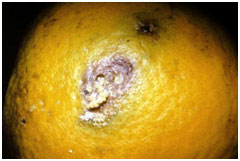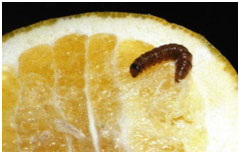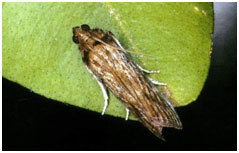Citripestis sagittiferella & Prays endocarpa.
What to look for
Deformed citrus fruit or citrus fruit with pock marks on the skin.
What you can do
- Do not move plants, plant material or fruit (especially citrus fruit) out of theTorres Strait Protected Zone to the Torres Strait Permanent Biosecurity Monitoring Zone, or from either zone to mainland Australia without a permit and an inspection by a Department of Agriculture and Water Resources biosecurity officer.
- Report any signs of citrus fruit damage or deformity to the Department of Agriculture and Water Resources by phone on +61 7 4241 7800 or email NAQS.
- Report any pale to green coloured insect larvae found in the pith and pulp of citrus fruit to the department by phone or email as listed above.

Profile
Citrus fruit borers are the larvae of citrus fruit moths. Larvae tunnel into the rind and flesh, leading to fruit rot and fruit drop. Citrus borers cause ugly pock marks on the skins of fruit, decreasing their market value and rendering fruit inedible.

Evidence of larvae outside the fruit
Identification
Eggs are laid in clusters on the underside of citrus fruit. The eggs hatch and larvae bore into the peel, later tunnelling into the pith and pulp. Larvae can be brown to pale green in colour. Mature caterpillars drop to the ground on silken thread to pupate in the soil. The moths, about 1 cm long, emerge after 10 days and are strong nocturnal flyers.
Distribution
Citrus fruit borers are found in Indonesia, Malaysia, Singapore, Vietnam and Thailand.

Citrus fruit borer caterpillar
Threat
If citrus fruit borers establish in northern Australia it may affect the production and marketing of locally grown fruit and could also spread to major citrus growing areas through the transportation of infected fruit.
Keep a Top Watch!
Infested fruit could be carried to Australia on fishing vessels from Indonesia or through the illegal importation of fruit through airports and seaports. If you see deformed citrus fruit, contact your nearest Department of Agriculture and Water Resources office.

Citrus fruit borer moth
Report citrus fruit with deformed or damaged skin.
